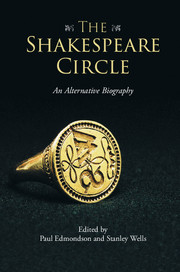Book contents
- Frontmatter
- Contents
- List of illustrations
- List of contributors
- Preface and acknowledgements
- General introduction
- Part I Family
- Part II Friends and Neighbours
- Part III Colleagues and Patrons
- 18 His fellow dramatists and early collaborators
- 19 His theatre friends: the Burbages
- 20 His fellow actors Will Kemp, Robert Armin and other members of the Lord Chamberlain's Men and the King's Men
- 21 His literary patrons
- 22 His collaborator George Wilkins
- 23 His collaborator Thomas Middleton
- 24 His collaborator John Fletcher
- 25 His editors John Heminges and Henry Condell
- Closing remarks
- Afterword
- Index
- References
23 - His collaborator Thomas Middleton
from Part III - Colleagues and Patrons
Published online by Cambridge University Press: 05 November 2015
- Frontmatter
- Contents
- List of illustrations
- List of contributors
- Preface and acknowledgements
- General introduction
- Part I Family
- Part II Friends and Neighbours
- Part III Colleagues and Patrons
- 18 His fellow dramatists and early collaborators
- 19 His theatre friends: the Burbages
- 20 His fellow actors Will Kemp, Robert Armin and other members of the Lord Chamberlain's Men and the King's Men
- 21 His literary patrons
- 22 His collaborator George Wilkins
- 23 His collaborator Thomas Middleton
- 24 His collaborator John Fletcher
- 25 His editors John Heminges and Henry Condell
- Closing remarks
- Afterword
- Index
- References
Summary
There's no case yet for the RSC's notepaper to be altered to read The Royal Shakespeare and Middleton and Others Company, but there must now be an argument for posters and programmes for future productions of Macbeth, Measure for Measure, Timon of Athens and now All's Well That End's Well carrying a joint credit to Shakespeare and Middleton.
Mark Lawson, ‘Let's face it: Shakespeare had help’, The Guardian 1 May 2012By the middle of the first decade of the seventeenth century, Middleton and Shakespeare must have known each other, and each other's work, pretty well. The extent and nature of that artistic relationship is, however, currently being rapidly rewritten. Scholars now agree that they collaborated on Timon of Athens, and a consensus is almost emerging that the texts of Macbeth and Measure for Measure in the 1623 Folio represent Middleton adaptations of Shakespeare plays. But – the recent suggestion of All's Well That Ends Well is a case in point – there's probably more to come (Maguire and Smith 2012a). Two contemporary critical strands converge to make it highly likely that further Middletonian collaboration or adaptation will be discovered in the Shakespeare canon: the new embrace of the collaborative energies of early modern theatre; and a quantifiable and increasingly robust understanding of the textual markers of Middleton's authorship. Currently, only the writing partnership with John Fletcher at the end of Shakespeare's career is known to have lasted beyond a single play, but Middleton may yet emerge as a more significant collaborator. In addition, Middleton's own plays show him to be a creative and responsive early reader and reviser of the older playwright's work.
Thomas Middleton was born in 1580 in Ironmonger Lane in St Lawrence parish in the city of London, just off the commercial thoroughfare of Cheapside that would be such a potent setting for many of his city plays. His father William was a wealthy bricklayer granted a coat of arms in 1568 and a crest showing a chained marmoset or ape. His mother Anne remarried in 1586 shortly after William's death.
Information
- Type
- Chapter
- Information
- The Shakespeare CircleAn Alternative Biography, pp. 297 - 304Publisher: Cambridge University PressPrint publication year: 2015
References
Accessibility standard: Unknown
Why this information is here
This section outlines the accessibility features of this content - including support for screen readers, full keyboard navigation and high-contrast display options. This may not be relevant for you.Accessibility Information
- 1
- Cited by
